THE GARDEN SPOT: What to do about large holes in your lawn
Published 6:15 am Wednesday, May 17, 2017

- Most experts suggest the best time to fill uneven spots in your lawn is during vigorous growth this time of year.
Question: I’ve got several good-sized holes in my yard. These aren’t small holes like those created by chipmunks or crayfish or ground-dwelling bees. These are large holes created when trees have been removed or a sinkhole has developed. Some are the result of machinery brought into the yard to repair a broken irrigation system. Bottom line, in several locations there is a chunk of dead turf or a hole where grass used to be that I’d like to replace. Should I just have a load of sand or topsoil dumped in my yard to fill in the bare spots, holes or sunken areas?
Answer: The answer is — it depends. If the issue is to level a turf grass lawn because it’s too bumpy to mow evenly or risk damaging the mower, then there are actions you can take short of hiring a company to do it for you, which is also an option.
If do-it-yourself is your choice and you’re willing to pace the process instead of trying make one application, this is a good time to start.
Most experts suggest the best time to fill uneven spots in your lawn is during vigorous growth this time of year. While coarse builders sand can be applied to fill very shallow spots of ½ inch or less, the majority of situations do much better with an application of a dry topsoil/sand mix. Some people add compost to the mix, which enriches the soil and gives that organic-matter boost to root growth. The key is to add no more than a 1/2 inch to an inch at a time, so roots can regenerate new growth that pushes up through the mix. After adding the leveling mixture, water the area to help settle it. If fertilizer is applied, use a light hand. If the area is still too low, let grass grow about four to six weeks, then another ½ inch of the mix can be added.
When low areas are more than a few inches deep, use an edger or sharp shovel to remove pieces of grass or ground cover, along with attached soil, from the bottom of the low area. Set them aside. Fill the depression with topsoil to bring it slightly higher than the surrounding soil, replace sections of grass or ground cover, and water it in. Watering will help settle material added to the depression and re-establish the roots of the removed vegetation. If there wasn’t anything growing in the low spot or hole, simply fill the spot using same process as above, then reseed, resod, vegetate the spot, or mulch it heavily to prevent weeds from moving in until you’ve decided what to do.
If the area is low and compacted, perhaps caused by heavy equipment, try using a digging fork under roots of grass or ground cover. Lift the roots up a couple of inches above surrounding grass or vegetation and let it settle back down – that may be enough to correct it. If not, use the same process outlined above to lift out any surviving vegetation, add topsoil or a topsoil and sand mix, then resettle vegetation. The objective is to open pore space in the soil so roots can re-establish.
Bottom line, dumping a load of sand and shoveling it into holes isn’t the best practice. Be patient even if it takes a couple of seasons to even out a really rough yard, fill in holes that used to be trees or other gaps in the ground.
For information on topics related to the home and garden, contact any office of the Alabama Cooperative Extension System. The Limestone County Office is located at 1109 West Market Street in Athens and office hours are 8 a.m. – 4:30 p.m. Monday through Friday. Phone number is 256-232-5510. Website is www.aces.edu.





